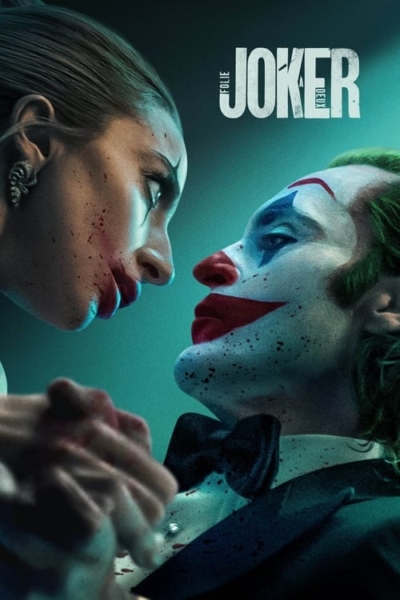Table of Contents
- 2. Plot Summary
- 3. What’s Good?
- Outstanding Performances
- Innovative Direction
- Cinematography and Art Direction
- Musical Score
- Psychological Depth
- 4. Strengths and Weaknesses
- Strengths
- Weaknesses
- 5. Target Audience
- 6. Box Office Details
- Budget and Collections
- Day-Wise Earnings:
- India (in crores):
- Overseas (in million USD):
- 7. Recommendation
- Genres:
- Rating:
- Cast:
- How is Our Review?
“Joker: Folie à Deux,” the much-anticipated sequel to the 2019 psychological thriller “Joker,” hit the big screens on October 4, 2024. Directed by Todd Phillips, this dark musical drama dives deeper into the fractured mind of Arthur Fleck, played masterfully by Joaquin Phoenix, and introduces Harley Quinn, portrayed by the multi-talented Lady Gaga. The film is a chilling blend of musical artistry, psychological exploration, and unrelenting tension.
This sequel steps away from conventional superhero tropes, instead embracing a raw, unsettling narrative that pushes boundaries. The chemistry between Phoenix and Gaga forms the backbone of the movie, which examines love, madness, and society’s role in shaping them. With its unique mix of musical interludes and intense storytelling, “Joker: Folie à Deux” promises to be as controversial as it is mesmerizing.
2. Plot Summary
Picking up where the first film left off, “Joker: Folie à Deux” delves into Arthur Fleck’s life after his transformation into Gotham’s notorious antihero. Institutionalized at Arkham Asylum, he crosses paths with Dr. Harleen Quinzel, a psychiatrist drawn to his enigmatic yet dangerous persona. Their interactions form the crux of the story as Harleen’s fascination spirals into obsession, leading to her evolution into Harley Quinn.
The narrative intertwines their descent into madness with the backdrop of a crumbling Gotham. Musical numbers add a surreal layer to their shared chaos, creating a sense of unease and beauty. While the plot is rich with twists and symbolism, it’s also an intense examination of mental illness, codependency, and societal neglect.
3. What’s Good?
Outstanding Performances
Joaquin Phoenix once again proves his mettle with a harrowing portrayal of Arthur Fleck. His ability to oscillate between vulnerability and menace is unparalleled. Lady Gaga’s portrayal of Harley Quinn is equally magnetic. She brings depth to Harleen Quinzel’s tragic descent, blending fragility and ferocity seamlessly.
Innovative Direction
Todd Phillips’ bold choice to incorporate musical elements adds a unique dimension to the film. The songs, often juxtaposed against dark or violent scenes, heighten the emotional impact and make the movie’s tone unpredictable.
Cinematography and Art Direction
The cinematography by Lawrence Sher captures Gotham in all its grimy glory. The use of dim lighting, muted colors, and striking contrasts reflects the characters’ mental states. Art direction plays a pivotal role, especially in creating Arkham Asylum’s haunting, labyrinthine aesthetic.
Musical Score
Hildur Guðnadóttir’s haunting score enhances the film’s atmosphere, blending classical melodies with eerie undertones. The original songs, performed by Gaga and Phoenix, are both haunting and captivating, further immersing audiences in the twisted narrative.
Psychological Depth
The movie’s exploration of complex themes like mental illness, toxic relationships, and societal neglect adds layers to the story. It’s not just a sequel but an introspective journey into human fragility and resilience.
4. Strengths and Weaknesses
Strengths
- Character Development: Arthur and Harleen’s arcs are meticulously crafted, making their descent into chaos believable and compelling.
- Visual and Musical Integration: The fusion of music and visuals creates a cinematic experience that is both jarring and beautiful.
- Brave Storytelling: The film takes risks with its narrative and stylistic choices, standing out in the crowded genre of comic book adaptations.
Weaknesses
- Pacing Issues: The film’s slower moments, especially in the first act, might test the patience of some viewers.
- Niche Appeal: Its dark themes and unconventional structure may not resonate with mainstream audiences.
- Overwhelming Symbolism: At times, the heavy use of metaphors and symbolism can feel pretentious, detracting from the story’s immediacy.
Despite these flaws, the film’s artistic ambition and emotional depth make it a standout entry in modern cinema.
5. Target Audience
“Joker: Folie à Deux” is not for the faint-hearted or casual moviegoers seeking light entertainment. It’s ideal for fans of psychological thrillers, musicals, and character-driven stories. Those who appreciated the first “Joker” or enjoy films that challenge societal norms will find it particularly captivating. Art film enthusiasts and Lady Gaga’s fans are also likely to connect with its unique vision. However, its mature themes make it unsuitable for younger audiences.
6. Box Office Details
Budget and Collections
The movie was made on a budget of approximately INR 1,200 crores (USD 150 million), reflecting its high production value and A-list cast. Within its first week, it garnered an impressive worldwide box office collection of INR 2,700 crores (USD 340 million), solidifying its status as a blockbuster.
Day-Wise Earnings:
India (in crores):
- Day 1: 35.5
- Day 2: 42.1
- Day 3: 55.3
- Day 4: 30.7
- Day 5: 27.4
Overseas (in million USD):
- Day 1: 12.8
- Day 2: 16.5
- Day 3: 20.3
- Day 4: 15.1
- Day 5: 13.6
The film’s massive success can be attributed to its strong pre-release buzz, critical acclaim, and the star power of Phoenix and Gaga. Its unique narrative also attracted audiences eager for something unconventional.
7. Recommendation
“Joker: Folie à Deux” is a cinematic masterpiece that defies genre conventions and challenges viewers’ perceptions. With outstanding performances, innovative direction, and a hauntingly beautiful narrative, it’s a film that lingers in your mind long after the credits roll. Highly recommended for those who seek depth and daring in their cinematic experiences.
Genres:
Drama, Crime, Thriller
Rating:
5.511/10
Cast:
| Actor | Character |
|---|---|
| Joaquin Phoenix | Arthur Fleck |
| Lady Gaga | Lee Quinzel |
| Brendan Gleeson | Jackie Sullivan |
| Catherine Keener | Maryanne Stewart |
| Zazie Beetz | Sophie Dumond |
| Steve Coogan | Paddy Meyers |
| Harry Lawtey | Harvey Dent |
| Leigh Gill | Gary Puddles |
| Ken Leung | Dr. Victor Liu |
| Jacob Lofland | Ricky Meline |
| Bill Smitrovich | Judge Herman Rothwax |
| Sharon Washington | Debra Kane |
| Alfred Rubin Thompson | Ernie Bullock |
| Connor Storrie | Young Inmate |
| Gregg Daniel | Music Teacher |
| Mac Brandt | Arkham Guard |
| George Carroll | Arkham Guard |
| John Lacy | Arkham Guard |
| Tim Dillon | Arkham Guard |
| Wayne Dehart | E Ward Inmate |
| Troy Fromin | E Ward Inmate |
| Ajgie Kirkland | E Ward Inmate |
| Terrance T.P. Polite | E Ward Inmate |
| Jimmy Walker Jr. | E Ward Inmate |
| Toney Wilson | E Ward Inmate |
| June Carryl | Dr. Louise Beatty |
| Don McManus | Paddy Meyers’ Producer |
| G.L. McQueary | Head Bailiff |
| Angela D. Watson | Jury Foreman |
| Murphy Guyer | White Chapel Minister |
| Carson Higgins | Junior Associate |
| Gattlin Griffith | Masked Joker Driver |
| Hudson Oz | Joker Doppelganger |
| Ray Lykins | Victim’s Dad |
| Will Ropp | Joker Fan #1 |
| Ashton Moio | Joker Fan #2 |
| Emilio Rojas | Joker Fan #3 |
| Joe Spinney | Police Escort |
| Richard Busser | Additional Guard |
| Brian Donahue | Additional Guard |
| Mike Houston | Additional Guard |
| Jess King | Additional Guard |
| Jimmy Smagula | Additional Guard |
| Stephen Stanton | Stan L. Brooks (voice) |
| Martin Kildare | News Anchor |
| Laurie Dawn | Reporter |
| Steven X. Greenfield | Reporter |
| Dominiqué Williams-Blair | Reporter |
| Barry Bonder | Reporter |
| Kaylah Sharve’ Baker | Back-up Singer |
| Ashley Levin | Back-up Singer |
| Celeste Butler | Back-up Singer |
| Alex Wesley Smith | Music Room Pianist |
| Robert Loftus | Arkham Guard (uncredited) |
| Nick Cave | Joker / Shadow (voice) (uncredited) |
How is Our Review?
Let us know if you liked our review of Joker: Folie à Deux through the comment box, so that we can keep creating such content for you.

